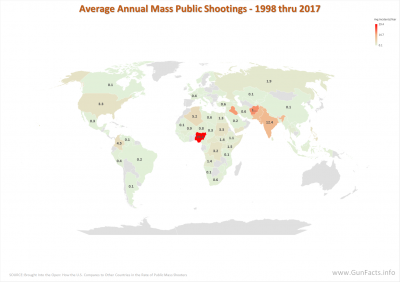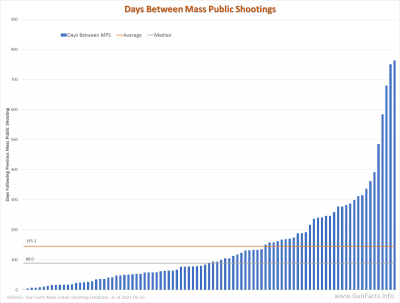There are two criminology definitions for public shootings, and they are very different:
Active Shooter Events (ASE): Where a person shoots at multiple people in public, though there may be no deaths. 1
Mass Public Shootings (MPS): Public shooting events where four or more people are killed, not including perpetrator(s). 2 Note: a 2012 definition created by Congress 3 uses 3+ victims as their definition, but criminologists adhere the original 4+ baseline.
Mass Shooting (MS): Event, regardless of public/private locations, with four or more people are killed (not including the perpetrator) within a 24 hour period. 4
Myth: U.S. Leads World in Mass Shootings
 |
 |
 |
 |
 |
 |
 |
Fact: This conclusion was in a paper 5 with multiple problems:
- Does not list the shooting events, so there is no way of validating the conclusion.
- Issues with the author’s unique definition of “mass shooting”, which does not align with those commonly used in criminology.
- Data collection methodologies, such as only gathering data from English language websites in foreign countries, which naturally would mask reports in local languages.
- Research going back to 1996, well before even the United States had broad media use of internet, meaning third world countries – even though publishing in English – likely did not post stories of older mass shootings.
Fact: A different study 6 with a significantly broader, multi-lingual and definition-precise dataset concluded that “While the US had about 4.6 percent of the world’s population … it had just 2.88 percent of the mass public shootings … The US ranks 58th in attack rate and 62st in murder rate.”
Myth: Mass public shootings are increasing
Fact: Over a 35-year period, the number of mass public shootings rose during the violence escalation decades of the 1970s and 1980, then leveled off in the late 1990s and the first years of the 21st century. Starting with a a couple of high-profile MPSs in 2012 (Sandy Hook Elementary and Aurora, Colorado), the population adjusted trendline has started rising in the U.S.
Special Note: The FBI created a study of what they labeled “active shooter” events from 2000-2013, but they merged both ASEs and MPSs. Combined, this data shows an increase whereas other studies that separate the two do not. But it must be noted that their study starts in the year 2000, which had an abnormally low number of public shootings (only one). 7
Myth: More people are dying in mass public shootings
Fact: The number of people killed in MPSs, as a percent of the population, was relatively stable until 2012, a year of seven MPSs, two large-scale. After and including that year, the total number of people killed has risen. But when exceptional events (such as the Las Vegas concert shooting) are factored-out, the fatality rate per year has remained relatively stable.
Fact: Mass public shooting deaths make up less than 1% of all gun homicides, making them a small part of the problem.
Myth: America has the highest rate of mass shootings in developed countries
Fact: On a per population basis, the United States ranks fourth behind three European countries 8 or eighth when a broader set of non-conflict countries are examined. 9
Myth: Mental health is not associated with mass shootings
Fact: At least 61% of mass public shooters 10 and 62% of active shooters 11 showed signs of mental instability in the days, weeks or months before their massacres. The rate for mass public shooters might be higher because medical privacy laws prevent fully exploring the mental health history of some killers.
Fact: 31% of perpetrators had experienced psychosis 12 whereas less than 0.1% of the general public develops a psychosis in any given year 13
Fact: 90% of attackers struggled with suicidality, mental illness or depression. 14
Fact: Killing for fame-seeking, which may be considered as sociopathic extreme within mental health, causes more deaths. “Fame-seeking rampage shooters killed an average of 7.2 victims, while the other offenders killed an average of 3.0 victims.” 15
Mental health is a key determinant variable.
Myth: Mass public shootings cluster due to a copycat effect
Fact: The spread of days between mass public shootings is broad, from one day to two years. 4% occur within a week of the previous one, and 19% within 30 days. However, the average span is 145 days, so whatever clustering there is on the low end is likely coincidental (since most mass public shooting perpetrators die and cannot be interviewed, there is scant data on if they were motivated by recent events).
Myth: Assault weapons (or high capacity magazines) cause higher fatality rates in mass shootings
Fact: “Civilian public mass shooting events with a handgun are more lethal than those associated with use of a rifle.” 16
Fact: Venue selection, especially with regards to the number of people packed into a small place (what we names a “cattle pen scenario“) is predictive, regardless of the weapon used.
Myth: Guns in civilian hands are not good for stopping mass public shooters
Fact: One tracking database 17 shows that 41.3% of “active shooter events” were terminated by armed civilians. Outside of “gun free zones” the rate climbs to 63.5%.
Fact: One study shows that armed citizens responding to rampage killers result in 1/8th the number of casualties than when police intervene. 18 In other words, waiting on the police results in eight times as many people deaths and injuries.
Fact: Some of the more well known instances of just people with concealed carry permits have prevented spree killings includes: 19
- Chicago, July 7, 2014: Denzel A. Mickiel cornered by fellow party-goer.
- Rockledge, Florida, November 24, 2017: Robert Bailey stopped by armed co-workers.
- Antioch, Tennessee, September 24, 2017: Emanuel Kidega Samson stopped by church usher.
- Arlington, Texas, May 3, 2017: James Jones shot by bar patron.
- Lyman, South Carolina, June 30, 2016: Jody Ray Thompson stopped after shooting three victims.
In this ongoing collection of reports, there are over 31 instances in recent reporting.
Understanding conflicting reports on “mass public shootings”
There are several different studies concerning mass public shootings, which make different claims. The primary points of confusion come from:
- How the counting of such shootings is done
- How they define “mass public shooting”
Here are some of the studies that are circulated and critiques of them.
Mother Jones 20
- This magazine report used media reports of mass shootings, which may not cover all such shootings and which lack criminological objectivity.
- There appear to be some arbitrary omissions of events that do not fit their definition of a public shooting.
- They only count “lone gunmen” events, and never the more common inner-city, gang-related multi-shooter episodes.
- They include terrorist activities, such as the Fort Hood massacre.
Mother Jones concluded that mass shootings occur more frequently than several decades ago, and that the mass public shooting rate tripled since 2011.
James Alan Fox, Northeastern University criminologist 21
- Based on police reports, which are uniform and comprehensive.
- Includes all mass shootings, including those not in public, which defies the idea of a mass public shooting.
Concluded that mass shooting rates remain relatively stable over time.
Grant Duwe, Minnesota Department of Corrections, criminologist 22
- Uses FBI Supplementary Homicide Reports for the core list, then media reports to provide details.
- Includes only public events.
- Excludes events related to other crimes (such as robberies gone wrong).
Concludes that mass public shootings declined from 1999 to 2011, then spiked in 2012 (the year of the Sandy Hook Elementary School shooting), then returned to the mean of previous years.
The one thing all of the studies agree upon is that
mass public shootings are statistically rare
Notes:
- “One or more persons engaged in killing or attempting to kill multiple people in an area (or areas) occupied by multiple unrelated individuals. At least one of the victims must be unrelated to the shooter. The primary motive appears to be mass murder; that is the shooting is not a by-product of an attempt to commit another crime.” United States Active Shooter Events from 2000 to 2010, School of Criminal Justice, Texas State University, 2014 – published by the Federal Bureau of Investigation ↩
- “Slaughter of four or more victims by one or a few assailants within a single event, lasting but a few minutes or as long as several hours”, Multiple Homicide: Patterns of Serial and Mass Murder, James Alan Fox, Jack Levin, Crime and Justice, Vol. 23, 1998 ↩
- Investigative Assistance for Violent Crimes Act of 2012 ↩
- A Comprehensive Assessment of Deadly Mass Shootings, 1980-2018 – Turanovic, Pratt, Neville, La Tosa – 2022 ↩
- Public Mass Shooters and Firearms: A Cross-National Study of 171 Countries, Lankford, 2016 ↩
- How a Botched Study Fooled the World About the U.S. Share of Mass Public Shootings — U.S. Rate is Lower than Global Average, Lott, 2018 ↩
- A Study of Active Shooter Incidents in the United States Between 2000 and 2013, FBI, September 2013
↩ - Mass Shootings: Media, Myths, and Realities, Jaclyn Schildkraut, H. Jaymi Elsass ↩
- The facts shoot holes in Obama’s claim that US is only host to mass killings, John Lott, December 2015 ↩
- Mass Shootings: Maybe What We Need Is a Better Mental-Health Policy, Mother Jones, November 2012, analysis of 62 mass public shootings ↩
- A Study of The Pre-Attack Behaviors of Active Shooters In The United States Between 2000 and 2013, Federal Bureau of Investigation, 2018 ↩
- Psychosis and mass shootings: A systematic examination using publicly available data; Peterson, Densley, Knapp, Higgins, Jensen; 2022 ↩
- “Understanding Psychosis”, National Institute of Mental Health, website 2023 ↩
- Repeat tragedy: Rampage shootings in American high school and college settings, 2002–2008. American Behavioral Scientist, 52, 1286–1308. ↩
- Fame-seeking rampage shooters: Initial findings and empirical predictions; Lankford; 2016 ↩
- Wounding Patterns Based on Firearm Type in Civilian Public Mass Shootings in the United States – 2018 – Sarani, Hendrix, Matecki, Estroff, Amdur, Robinson, Shapiro, Gondek, Mitchell, Smith – Journal of the American College of Surgeons ↩
- Massive errors in FBI’s Active Shooting Reports from 2014-2022 regarding cases where civilians stop attacks; Crime Prevention Research Center; 2023 ↩
- Auditing Shooting Rampage Statistics, Davi Barker, July 2013 and updated thereafter ↩
- Crime Prevention Research Center web site ↩
- A Guide to Mass Shootings in America, Mother Jones, May 2014 ↩
- Mass Shootings in America: Moving Beyond Newtown, Homicide Studies, 2013 ↩
- Mass Murder in the United States: A History, McFarland, June 2007 ↩

